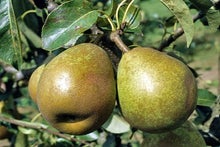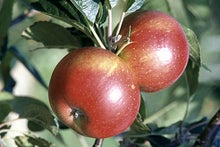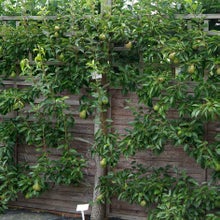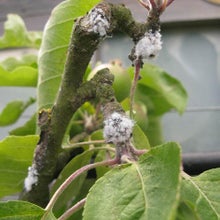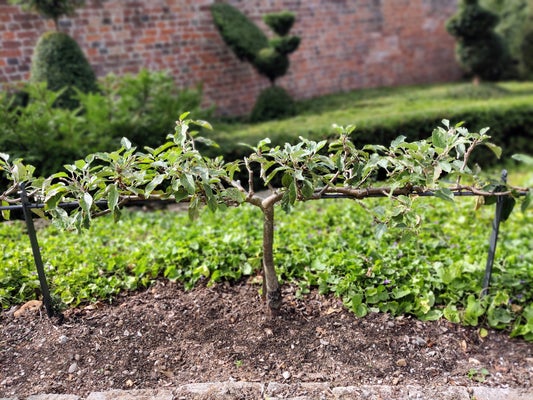
Quick facts
Low-growing and compact, from only 45cm (18in) tall
Annual pruning is essential to maintain the shape
Can be trained from scratch or bought pre-trained
Choose a spur-bearing cultivar grafted onto a very dwarfing rootstock
Unless growing a self-fertile cultivar, a pollinating partner tree is needed
Before you start
What is a stepover?
A stepover is a tree with a short vertical trunk, usually topped with a pair of branches (or arms) trained horizontally on either side to form a T-shape. They can also just have one arm. Typically the trunk is 45–60cm (18–24in) tall. The arms of a T-shaped (two-arm) stepover can span up to 3–3.5 (10–11½) in total. If training a stepover with one arm, the arm will typically extend 1.5–1.8m (58–6ft). Fruit is produced on short side-shoots along the horizontal branches. Several trees are often grown in a row, to line a path or edge a bed.
Stepovers make very attractive, space-saving features and are perfect for small gardens, but they do need pruning every year in late summer, to retain their shape and ensure good fruiting.
Stepovers are created in two main ways:
- Single-tier espaliers – these are trained in the same way as espaliers, but with just one tier of horizontal branches
- Horizontal cordons – these are created using a modified method of oblique cordon training. The stem is gradually bent and the upper part lowered to a horizontal position to form a single-arm stepover
You can buy pre-trained or partly trained stepovers or train them yourself from scratch.
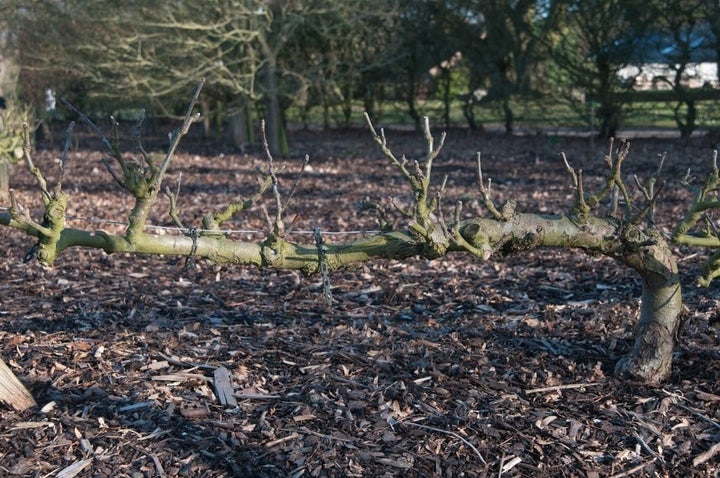
Rootstock and cultivar choices
Apple and pear trees are sold as grafted plants, comprising a rootstock (which controls the plant’s size) and a cultivar (which forms the upper part). To make a successful stepover, it’s important to buy a tree that combines a suitable rootstock and .
For such a compact trained form, the tree must have a very dwarfing rootstock:
- M27 for apples – very dwarfing, it’s the best option for stepover training
- M9 for apples – dwarfing, useful for stepovers grown in poor soil
- M26 for apples – dwarfing, suitable for conventional cordons, but can be too vigorous for stepovers, so preferably look for trees grafted onto a more dwarfing rootstock
- Quince C and Quince Eline for pears – semi-dwarfing, the best choices for stepovers
To ensure the stepover fruits well and is easy to keep in shape, it’s important to choose the right type of cultivar for the upper part of the tree:
- Spur-bearing cultivars are best suited for stepover training, as they carry their fruit on short side-shoots known as spurs
- Partial tip-bearers may be trained as stepovers, although some are more challenging to maintain than others – see FAQs below.
- Tip-bearers aren’t suitable for stepover training
Unless the cultivar you choose is self-fertile or partly self-fertile, you’ll need another compatible cultivar (from the same pollination group) in your own or a neighbour’s garden to ensure a good crop – see our guide to fruit pollination for more details.
Pre-trained or untrained trees
Depending on how much training you want to do, you can buy partly or fully trained stepovers or you can start with a one-year-old tree (known as a maiden) and train it entirely from scratch. Both trained and untrained trees are mainly available from online suppliers.
Pre-trained stepovers are generally either single-tier espaliers with a short central trunk and two horizontal branches (arms), or modified cordons with short trunk and one horizontal arm.
These are the more expensive option, but their shape is usually fully formed. You just need to train the new growth on the ends of the horizontal arms until they reach the desired length. Start regular summer pruning of the side-shoots straight away, as for an established espalier.
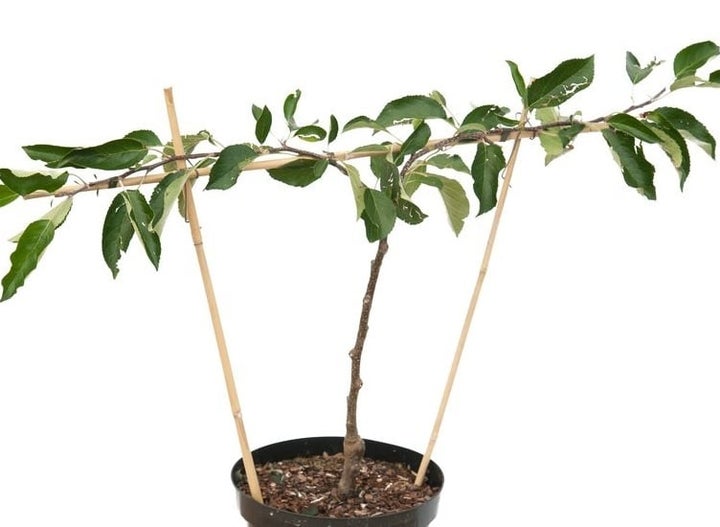
Partly trained stepovers are generally supplied as Y-shaped trees with two strong shoots. These need to be gradually lowered in opposite directions until horizontal, in the way described for training a stepover from scratch, below. They are usually cheaper than fully trained trees, but bending the shoots may be difficult.
Untrained trees give you the opportunity to train your own stepover – buy a one-year-old tree, known as a maiden, which is single-stemmed, with or without side-shoots (feathered or unfeathered maiden). If you want to train it using the modified method (see below), it’s essential to buy a very young, pliable tree. Maidens are usually cheaper than pre-trained trees and you’ll have a wider choice of cultivars, but you must choose your tree carefully, selecting a suitable rootstock and cultivar (see above) for this compact style, and it will take at least a year to train the basic shape.
How to plant and support stepovers
Stepovers need permanent support. Insert robust vertical posts, spacing them 1.5–3m (5–10ft) apart, depending on how many stepovers you are growing and how long you want the arms to grow. The posts should be slightly taller than the stepover height.
Fix a galvanised wire (2.5mm, gauge 12) horizontally between the posts, making sure it stays taut, to support the arms of your stepover. With a pre-trained stepover, it’s best to wait until after planting to put the wire in place, so you can position it at the correct height. Don’t simply plant your deeper to suit the wire. Trees should be planted with the first roots just below the soil surface, and with the graft point (usually a bulge on the stem) well above it.
Stepovers, whether trained or untrained, are easy to plant, in exactly the same way as free-standing trees. See our step-by-step guide to planting a tree.
Training stepovers from scratch
Stepovers can be trained in two different ways, both starting with a one-year-old tree, known as a maiden. It can either have side-shoots (a feathered maiden) or not (an unfeathered maiden).
Single-tier espalier – for a two-arm stepover
This method is almost identical to training a new espalier from scratch, but quicker as only one horizontal tier is required.

In the first winter:
- Plant the single-stemmed tree just in front of the horizontal wire, which should be positioned at the height you want the arms – usually between 45cm (18in) and 60cm (2ft) from the ground. Insert a bamboo vertically and attach it to the wire stretched between sturdy posts, then tie in the lower part of the stem to the cane
- Prune back the stem to just above the wire, making your cut above a heathy
- The two uppermost will produce shoots in spring that will form the two side branches
In the first spring/summer:
- Select two strong side-shoots at the top of the main stem, one on each side, which will become the horizontal branches. Initially, these need to be trained at a 40° angle, to form a Y-shape, as this will promote strong growth. Don’t train them horizontally to start with, as that would reduce their vigour
- To support the two side-shoots in the Y position, insert bamboo canes into the ground angled at 40°, and attach to the wire. You’re also likely to need additional vertical canes to help hold them securely. Tie the two side-shoots to the angled canes to keep them straight and in the correct position
- In late summer, lower the two side-shoots to the horizontal wire to form the T-shape, once they’ve stopped growing
- Prune back all the other side-shoots to two or three leaves
In the second winter/early spring:
- If the horizontal branches grow poorly, cut them back by up to a quarter. Also consider raising them back at 40° in spring to encourage stronger growth. Lower them to horizontal again in late summer
- Remove any other side-shoots growing directly from the main stem
From the second summer onwards:
- Start pruning annually in late summer, in the same way as established espaliers
- All stepovers require consistent pruning every summer to keep them in good shape and fruiting well
Modified cordon training – for a single-arm stepover
For this method, the young tree must be very pliable, so it’s able to withstand being gradually bent over to horizontal.
In the first winter:
- Plant the maiden tree next to one of the sturdy upright posts and tie the stem to it
- If the tree has side-shoots (a feathered maiden), remove any on the lower part of the stem that will remain upright
- Then cut back any other side-shoots (laterals) that are longer than 10cm (4in) to three or four buds. Leave any shorter side-shoots unpruned
In the first spring:
- Once there are signs of growth from the buds, start gradually and carefully bending the top part of the tree towards the horizontal wire. The vertical, lower part needs to be well secured to the post to make sure it remains upright
- Tie the top part of the stem to the wire in several places to distribute the pressure and ensure it bends evenly. Take care not to overstrain the ties, to avoid bending the stem too far too quickly, which would risk breaking it
- Over time, gradually shorten the ties. Take it slowly – the steady bending of the stem may take the whole growing season
In the first summer:
- Prune the side-shoots as for new cordons, so they form fruiting spurs
- Leave the end of the main stem unpruned and tie in its additional growth to the horizontal wire
Second summer onwards:
- Start pruning annually in late summer, in the same way as established oblique cordons
- Keep the main stem unpruned until the arm reaches the desired length, then cut just above a bud
- All stepovers require consistent pruning every summer to keep them in good shape and fruiting well
Pruning established stepovers
Established stepovers require regular pruning every year in late summer to retain the shape and ensure good fruiting. The annual maintenance summer pruning of the current season’s growth is the same for two-arm stepovers (single tier ) and one arm stepovers (horizontal ). They are pruned as for established espaliers or oblique cordons .
Frequently asked questions
My stepover is becoming very bushy on the bent part of the stem close to the upright trunk. What can I do?
The side-shoots in that area have a tendency to be more vigorous due to a higher concentration of growth ( ). Thin out these side-shoots in winter, removing the most vigorous ones entirely.
How can I train a partial tip-bearers as a stepover?
Although it’s best to use spur-bearing cultivars, it is also possible to train partial tip-bearers as stepovers. Some, such as ‘Discovery’ and ‘Charles Ross’, are easily maintained, but others, such as ‘Worcester Pearmain’ and ‘Bramley’s Seedling’, can potentially be difficult to manage. The key difference when summer pruning is to leave several shorter new side-shoots that are about 20cm (8in) or less unpruned every year. These shorter side-shoots are likely to have developed a fruit at the tip.
I missed the summer pruning, what should I do?
It’s better to prune in winter than not at all, to prevent the fruiting spurs growing too long. So once the tree is , prune back last year’s shoots coming from the horizontal branches to 5–7.5cm (2–3in) long, cutting just above a bud. Also shorten shoots from the existing spurs to 2.5–5cm (1–2in) long. Then resume annual summer pruning.
Why do I get significant re-growth after summer pruning?
There are two potential reasons:
- You may be pruning too early, before growth slows down. Try delaying until September, when larger terminal (end) have formed at the shoot tips and the shoots have stopped growing
- If pruning is followed by a spell of good growing conditions (warmth and rain), growth may re-start. Prune back any re-growth in September (or October if pruning later) to one leaf beyond your previous cut.
My stepover has grown outwards from its support and is now taking up too much space. What can I do?
Over time, the side-shoots from the horizontal branches can become too long. Try gradual renovation:
- Prune them right back in winter to stubs 3–5cm (1–2in) long, cutting just above a well-placed . But take care not to remove more than a third of the side-shoots in any one year
- Spread this pruning evenly around the plant and over several winters
- Follow this pruning by normal summer pruning annually
Problem solving
When pruning, you may notice signs of apple canker on the stems – affected growth should be cut out where possible. Late frosts can damage the blossom and youg developping fruit which may affect fruit production.
Be aware of biennial bearing, when a tree crops unevenly, producing a bumper crop one year, followed a poor crop the next. Fruit thinning will help to get regular crops.
